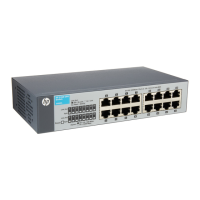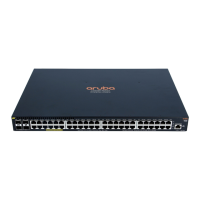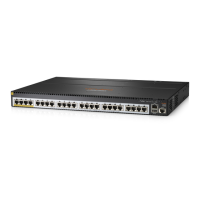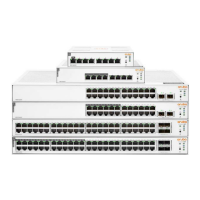60
• Configuring the priority marking actions by color in the traffic policing action.
• Configuring the priority marking actions by color in the behavior where the traffic policing action
is configured.
You can use both methods to mark multiple priority values for packets in the same color. However, do
not use the two methods to mark different values of the same priority type for packets. Otherwise, the
QoS policy configured with the behavior cannot be applied normally.
In a traffic behavior, an aggregate CAR action cannot be configured together with a priority marking
action. Otherwise, the QoS policy configured with the behavior cannot be applied normally.
The switch implements both common CAR and aggregate CAR by using a QoS policy. For more
information about configuring classes and behaviors in a QoS policy, see "Configuring traffic policing,
GTS, and rat
e limit" and "Configuring aggregate CAR."
Configuring priority marking based on colors obtained through mapping drop precedence
When packets are colored based on drop precedence values, you can create priority marking
actions for packets in different colors in a traffic behavior and mark DSCP values, 802.1p priority
values, and local precedence values for packets.
Configuration procedure
To configure priority marking:
Step Command Remarks
1. Enter system view.
system-view
N/A
2. Create a traffic class and
enter traffic class view.
traffic classifier
classifier-name [
operator
{
and
|
or
} ]
By default, no traffic
class exists.
3. Configure match criteria.
if-match
match-criteria
By default, no match
criterion is configured.
For more information
about the
if-match
command, see ACL and
QoS Command
Reference.
4. Return to system view.
quit
N/A
5. Create a traffic behavior
and enter traffic behavior
view.
traffic behavior
behavior-name
By default, no traffic
behavior exists.
6. Configure a priority
marking action.
• Set the DSCP value for packets:
remark [ green | red | yellow ] dscp
dscp-value
• Set the 802.1p priority for packets or
configure the inner-to-outer tag priority
copying function:
remark [ green | red | yellow ] dot1p
dot1p-value
remark dot1p customer-dot1p-trust
• Set the drop priority for packets:
remark drop-precedence
drop-precedence-value
• Set the IP precedence for packets:
remark ip-precedence
ip-precedence-value
• Set the local precedence for packets:
remark[ green | red | yellow ]
By default, no priority
marking action is
configured.
The switch supports
local QoS IDs in the
range of 1 to 3999.
The
remark
local-precedence
,
remark qos-local-id
,
and
remark
drop-precedence
commands apply only to
the incoming traffic.
The customer VLAN
(CVLAN) is the private
network VLAN of the
customer, and the

